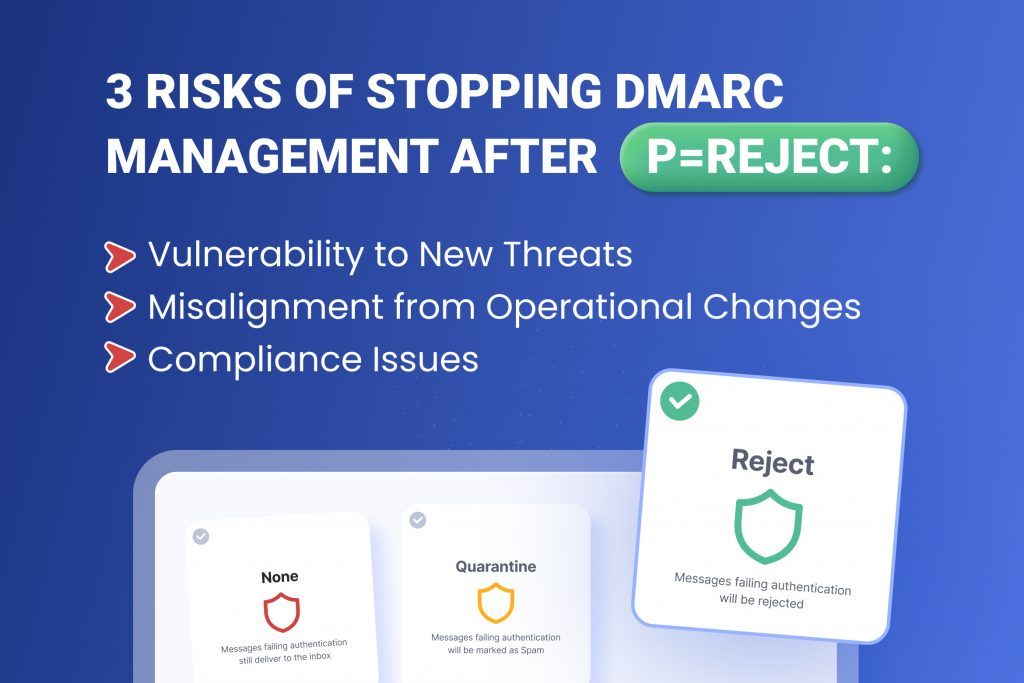
2024-10-2 16:29:0 Author: securityboulevard.com(查看原文) 阅读量:4 收藏
Reaching p=reject does not mean your DMARC management can be put on autopilot. Continuous monitoring, regular reporting, and timely alerts remain crucial as your organization evolves and the risks change. A DMARC Reject Policy is the most robust email authentication policy your organization can have, but meeting this golden standard is not a time for complacency.
Let’s examine why DMARC maintenance and management remain crucial, even when you have a DMARC Reject policy.
The Risks of Stopping DMARC Management After p=Reject

Stopping DMARC monitoring after achieving a DMARC Reject Policy exposes your organization to the following risks:
1. Vulnerability to New Threats: New phishing tactics and unauthorized email systems introduced by other departments can bypass IT oversight. Without regular monitoring, you may miss early warning signs of these threats.
2. Misalignment from Operational Changes: Changes in infrastructure, email providers, or third-party services affect DMARC alignment. Regular monitoring ensures adjustments are made to avoid rejecting legitimate emails.
3. Compliance Issues: Many industries and regulatory bodies have specific email authentication requirements. Ongoing DMARC maintenance ensures compliance with these standards.
What to Focus On Beyond DMARC Reject

There are three essential aspects of DMARC maintenance you should focus on after attaining a DMARC Reject policy – reporting, alerts, and monitoring.
1. Tracking DMARC Performance Through Weekly Reports
Continuous monitoring of your DMARC reports is essential to maintain security. Regular reports allow you to assess the effectiveness of your policy and detect issues like unauthorized senders or misaligned third-party services.
Weekly or bi-weekly reports should be analyzed to:
- Track key metrics like DMARC alignment and policy enforcement so you can ensure that your legitimate emails continue to be delivered
- Identify anomalies or emerging threats
- Investigate false positives to prevent legitimate emails from being rejected.
How EasyDMARC Can Help: EasyDMARC’s Aggregate Reports make this process easy by providing detailed, user-friendly insights into your domain’s email activity. These reports allow you to spot trends and take corrective action quickly. We also send you weekly analyses that give a holistic overview of your Aggregate Report’s health.
2. Staying Ahead of Threats with Real-Time DMARC Alerts
An effective alert system is your first defense against email security breaches. Timely alerts notify you of critical events, such as alignment failures or unauthorized IP addresses attempting to send emails on behalf of your domain. Without notifications, you risk overlooking critical issues until they escalate.
Alerts allow you to:
- Catch significant changes in email traffic or alignment rates
- Respond swiftly to prevent any potential damage or deliverability issues.
How EasyDMARC Can Help: Our platform notifies you of suspicious activity related to DNS Records and Blocklists, enabling you to take quick action and keep your domain secure.
3. Fine-Tuning Your DMARC Policy Through Monitoring
Even after reaching p=reject, regular policy adjustments are necessary to adapt to changes within your organization. New vendors or email services may need to be added to your SPF or DKIM records to ensure proper authentication. Additionally, cyber threats constantly evolve, and your DMARC policy should reflect the latest best practices.
Regular monitoring helps to:
- Adapt to new threats by adjusting policies accordingly
- Ensure deliverability by keeping up with legitimate sending sources
- Stay compliant with evolving industry standards.
How EasyDMARC Can Help: EasyDMARC provides an intuitive platform to regularly monitor and analyze your DMARC reports, ensuring your domain’s security remains up-to-date with the latest threats and changes in your organization.
Conclusion
Achieving p=reject is a victory, but it’s a battle that never truly ends. The real challenge lies in maintaining vigilance. Regular monitoring, timely alerts, and detailed reporting are not optional – they’re essential. Neglecting these aspects leaves your organization exposed to evolving threats and compliance issues. The cost of DMARC complacency is far greater than what it takes to maintain it.
The post What Happens After p=Reject: Beyond the DMARC Golden Standard appeared first on EasyDMARC.
*** This is a Security Bloggers Network syndicated blog from EasyDMARC authored by Sarah Wilson. Read the original post at: https://easydmarc.com/blog/what-happens-after-preject-beyond-the-dmarc-golden-standard/
如有侵权请联系:admin#unsafe.sh
